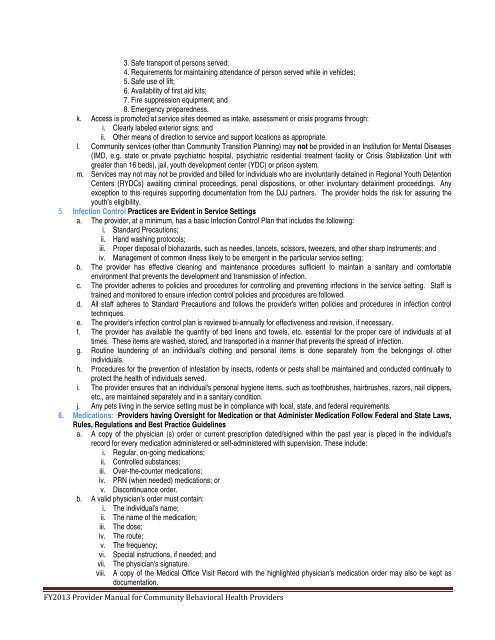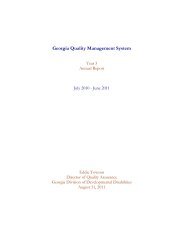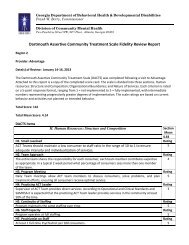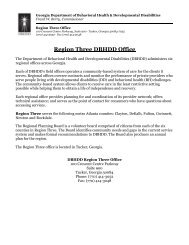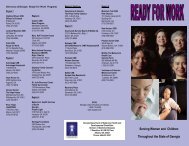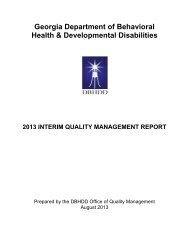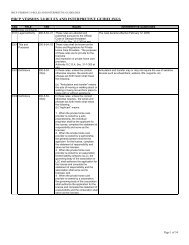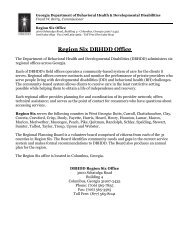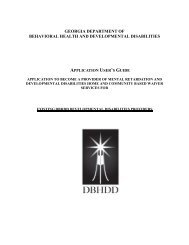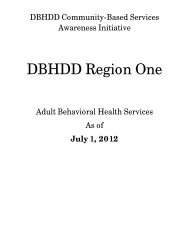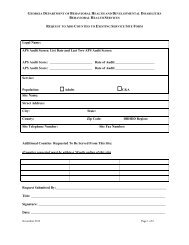i. All local <strong>and</strong> state ordinances are addressed;1. Copies <strong>of</strong> inspection reports are available;2. Licenses or certificates are current <strong>and</strong> available as required by the site or the service.e. There is evidence <strong>of</strong> compliance with state <strong>and</strong> county <strong>of</strong> residence fire <strong>and</strong> life safety codes for the following:i. Installation <strong>of</strong> fire alarm system meets safety code;ii. Fire drills are conducted for individuals <strong>and</strong> staff:1. Once a month at alternating times; including2. Twice a year during sleeping hours if residential services.3. All fire drills shall be documented with staffing involved4. DBHDD maintains the right to require an immediate demonstration <strong>of</strong> a fire drill during any on-site visitf. Policies, plans <strong>and</strong> procedures are in place that addresses emergency evacuation, relocation preparedness <strong>and</strong> DisasterResponse. Supplies needed for emergency evacuation are maintained in a readily accessible manner, includingindividuals' information, family contact information <strong>and</strong> current copies <strong>of</strong> physician’s orders for all individual’s medications.i. Plans include detailed information regarding evacuating, transporting, <strong>and</strong> relocating individuals that coordinatewith the local Emergency Management Agency <strong>and</strong> at a minimum address:1. Medical emergencies;2. Missing persons;a. Georgia's Mattie's Call Act provides for an alert system when an individual with developmentaldisabilities, dementia, or other cognitive impairment is missing. Law requires residences licensedas Personal Care Homes to notify law enforcement within 30 minutes <strong>of</strong> discovering a missingindividual.3. Natural disasters known to occur, such as tornadoes, snow storms or floods;4. Power failures;5. Continuity <strong>of</strong> medical care as required;6. Notifications to families or designees; <strong>and</strong>7. Effective 7/1/2012, Continuity <strong>of</strong> Operation Planning to include identifying locations <strong>and</strong> providing a signedagreement where individuals will be relocated temporarily in case <strong>of</strong> damage to the site where services areprovided (for more information: www.georgiadisaster.info, http://www.fema.gov/about/org/ncp/coop/templates.shtm)ii. Emergency preparedness notice <strong>and</strong> plans are:1. Reviewed annually;2. Tested at least quarterly for emergencies that occur locally on a less frequent basis such as, but not limitedto flood, tornado or hurricane;3. Drilled with more frequency if there is a greater potential for the emergency.g. Providers must comply with federal Public Law 103-227 which requires that smoking not be permitted in any portion <strong>of</strong> anyindoor facility owned, leased, or contracted by the provider <strong>and</strong> used routinely or regularly for the provision <strong>of</strong> health carefor youth under the age <strong>of</strong> 18. MHBG, SAPTBGh. Residential living support service options;i. Are integrated <strong>and</strong> established within residential neighborhoods;ii. Are single family units;iii. Have space for informal gatherings;iv. Have personal space <strong>and</strong> privacy for persons supported; <strong>and</strong>v. Are understood to be the “home” <strong>of</strong> the person supported or served.i. Video cameras may be used in common areas <strong>of</strong> programs that are not personal residences such as Crisis StabilizationUnits where visualization <strong>of</strong> blind areas is necessary for an individual’s safety. Cameras may not be used in the followinginstances:i. In an individual’s personal residence;ii. In lieu <strong>of</strong> staff presence; oriii. In the bedroom <strong>of</strong> individualsj. There are policies, procedures, <strong>and</strong> practices for transportation <strong>of</strong> persons supported or served in residential services <strong>and</strong>in programs that require movement <strong>of</strong> persons served from place to place.i. Policies <strong>and</strong> procedures apply to all vehicles used, including:1. Those owned or leased by the provider;2. Those owned or leased by subcontractors; <strong>and</strong>3. Use <strong>of</strong> personal vehicles <strong>of</strong> staff.ii. Policies <strong>and</strong> procedures include, but are not limited to:1. Authenticating licenses <strong>of</strong> drivers, pro<strong>of</strong> <strong>of</strong> insurance, <strong>and</strong> routine vehicle maintenance;2. Requirements for evidence <strong>of</strong> driver training;FY2013 Provider Manual for Community <strong>Behavioral</strong> <strong>Health</strong> Providers
3. Safe transport <strong>of</strong> persons served;4. Requirements for maintaining attendance <strong>of</strong> person served while in vehicles;5. Safe use <strong>of</strong> lift;6. Availability <strong>of</strong> first aid kits;7. Fire suppression equipment; <strong>and</strong>8. Emergency preparedness.k. Access is promoted at service sites deemed as intake, assessment or crisis programs through:i. Clearly labeled exterior signs; <strong>and</strong>ii. Other means <strong>of</strong> direction to service <strong>and</strong> support locations as appropriate.l. Community services (other than Community Transition Planning) may not be provided in an Institution for Mental Diseases(IMD, e.g. state or private psychiatric hospital, psychiatric residential treatment facility or Crisis Stabilization Unit withgreater than 16 beds), jail, youth development center (YDC) or prison system.m. Services may not may not be provided <strong>and</strong> billed for individuals who are involuntarily detained in Regional Youth DetentionCenters (RYDCs) awaiting criminal proceedings, penal dispositions, or other involuntary detainment proceedings. Anyexception to this requires supporting documentation from the DJJ partners. The provider holds the risk for assuring theyouth’s eligibility.5. Infection Control Practices are Evident in Service Settingsa. The provider, at a minimum, has a basic Infection Control Plan that includes the following:i. St<strong>and</strong>ard Precautions;ii. H<strong>and</strong> washing protocols;iii. Proper disposal <strong>of</strong> biohazards, such as needles, lancets, scissors, tweezers, <strong>and</strong> other sharp instruments; <strong>and</strong>iv. Management <strong>of</strong> common illness likely to be emergent in the particular service setting;b. The provider has effective cleaning <strong>and</strong> maintenance procedures sufficient to maintain a sanitary <strong>and</strong> comfortableenvironment that prevents the development <strong>and</strong> transmission <strong>of</strong> infection.c. The provider adheres to policies <strong>and</strong> procedures for controlling <strong>and</strong> preventing infections in the service setting. Staff istrained <strong>and</strong> monitored to ensure infection control policies <strong>and</strong> procedures are followed.d. All staff adheres to St<strong>and</strong>ard Precautions <strong>and</strong> follows the provider's written policies <strong>and</strong> procedures in infection controltechniques.e. The provider's infection control plan is reviewed bi-annually for effectiveness <strong>and</strong> revision, if necessary.f. The provider has available the quantity <strong>of</strong> bed linens <strong>and</strong> towels, etc. essential for the proper care <strong>of</strong> individuals at alltimes. These items are washed, stored, <strong>and</strong> transported in a manner that prevents the spread <strong>of</strong> infection.g. Routine laundering <strong>of</strong> an individual's clothing <strong>and</strong> personal items is done separately from the belongings <strong>of</strong> otherindividuals.h. Procedures for the prevention <strong>of</strong> infestation by insects, rodents or pests shall be maintained <strong>and</strong> conducted continually toprotect the health <strong>of</strong> individuals served.i. The provider ensures that an individual's personal hygiene items, such as toothbrushes, hairbrushes, razors, nail clippers,etc., are maintained separately <strong>and</strong> in a sanitary condition.j. Any pets living in the service setting must be in compliance with local, state, <strong>and</strong> federal requirements.6. Medications: Providers having Oversight for Medication or that Administer Medication Follow Federal <strong>and</strong> State Laws,Rules, Regulations <strong>and</strong> Best Practice Guidelinesa. A copy <strong>of</strong> the physician (s) order or current prescription dated/signed within the past year is placed in the individual'srecord for every medication administered or self-administered with supervision. These include:i. Regular, on-going medications;ii. Controlled substances;iii. Over-the-counter medications;iv. PRN (when needed) medications; orv. Discontinuance order.b. A valid physician's order must contain:i. The individual's name;ii. The name <strong>of</strong> the medication;iii. The dose;iv. The route;v. The frequency;vi. Special instructions, if needed; <strong>and</strong>vii. The physician's signature.viii. A copy <strong>of</strong> the Medical Office Visit Record with the highlighted physician's medication order may also be kept asdocumentation.FY2013 Provider Manual for Community <strong>Behavioral</strong> <strong>Health</strong> Providers
- Page 1 and 2:
Georgia Department of Behavioral He
- Page 3 and 4:
UPDATED FOR JULY 1, 2013SUMMARY OF
- Page 5 and 6:
C&A Core ServicesBehavioral Health
- Page 7 and 8:
Community Supportsupports;9) Assist
- Page 9 and 10:
Community SupportServiceAccessibili
- Page 11 and 12:
Community Transition Planningv. App
- Page 13 and 14:
Diagnostic AssessmentTransactionCod
- Page 15 and 16:
Family Outpatient Services: Family
- Page 17 and 18:
Family Outpatient Services: Family
- Page 19 and 20:
Family Outpatient Services: Family
- Page 21 and 22:
Group Outpatient Services: Group Co
- Page 23 and 24:
Group Outpatient Services: Group Tr
- Page 25 and 26:
Individual CounselingServiceDefinit
- Page 27 and 28:
Medication AdministrationAdmissionC
- Page 29 and 30:
Nursing Assessment and Health Servi
- Page 31 and 32:
Continuing StayCriteriaDischargeCri
- Page 33 and 34:
Psychiatric TreatmentAdditionalMedi
- Page 35 and 36:
Service Plan DevelopmentPractitione
- Page 37 and 38:
CHILD & ADOLESCENT SPECIALTY SERVIC
- Page 39 and 40:
Behavioral AssistanceAssistance.Ser
- Page 41 and 42:
Crisis Stabilization Unit (CSU) Ser
- Page 43 and 44:
Crisis Stabilization Unit (CSU) Ser
- Page 45 and 46:
Intensive Family Intervention5. Bec
- Page 47 and 48:
Intensive Family Interventionconfid
- Page 49 and 50:
Intensive Family Intervention10. Th
- Page 51 and 52:
Structured Activity SupportsService
- Page 53 and 54:
Structured Residential SupportsClin
- Page 55 and 56:
Substance Abuse Intensive Outpatien
- Page 57 and 58:
Substance Abuse Intensive Outpatien
- Page 59 and 60:
Substance Abuse Intensive Outpatien
- Page 61 and 62:
RequiredComponents1. Any diagnosis
- Page 63 and 64:
Community Support3. Contact must be
- Page 65 and 66:
Community Transition Planning3. Jai
- Page 67 and 68:
ContinuingStay CriteriaDischargeCri
- Page 69 and 70:
Family Outpatient Services: Family
- Page 71 and 72:
Family Outpatient Services: Family
- Page 73 and 74:
Family Outpatient Services: Family
- Page 75 and 76:
Group Outpatient Services: Group Co
- Page 77 and 78:
Group Outpatient Services: Group Tr
- Page 79 and 80:
Individual CounselingServiceDefinit
- Page 81 and 82:
StaffingRequirementsServiceAccessib
- Page 83 and 84:
Medication Administrationliving.Req
- Page 85 and 86:
Nursing Assessment and Health Servi
- Page 87 and 88:
Psychiatric Treatmentbehaviormodify
- Page 89 and 90:
Psychological Testing: Psychologica
- Page 91 and 92:
Service Plan DevelopmentRecovery pl
- Page 93 and 94:
Ambulatory Substance Abuse Detoxifi
- Page 95 and 96:
Assertive Community Treatmente. Ass
- Page 97 and 98:
Assertive Community Treatment• Di
- Page 99 and 100:
Assertive Community Treatment• di
- Page 101 and 102: Assertive Community Treatment11. Fo
- Page 103 and 104: Assertive Community Treatmentin whi
- Page 105 and 106: Consumer/Family AssistanceTransacti
- Page 107 and 108: Consumer/Family Assistancecriticaln
- Page 109 and 110: Crisis Stabilization Unit Servicesb
- Page 111 and 112: ClinicalExclusionsDocumentationRequ
- Page 113 and 114: Peer Support Services4. Individual
- Page 115 and 116: Peer Support ServicesClinicalOperat
- Page 117 and 118: Psychosocial RehabilitationUnit Val
- Page 119 and 120: Psychosocial Rehabilitationmust dem
- Page 121 and 122: Psychosocial RehabilitationBilling
- Page 123 and 124: Residential: Independent Residentia
- Page 125 and 126: Residential: Intensive Residential
- Page 127 and 128: Residential: Semi-Independent Resid
- Page 129 and 130: Residential Substance Detoxificatio
- Page 131 and 132: ServiceDefinitionAdmissionCriteriaC
- Page 133 and 134: AdmissionCriteria,continuedContinui
- Page 135 and 136: 1. It is expected that the transiti
- Page 137 and 138: DocumentationRequirements1. Every a
- Page 139 and 140: FY2013 Provider Manual for Communit
- Page 141 and 142: TABLE B: Physicians, Physician’s
- Page 143 and 144: COMMUNITY SERVICE STANDARDS FOR ALL
- Page 145 and 146: 3. The provider details the desired
- Page 147 and 148: 7. The provider’s practice of cul
- Page 149 and 150: c. Is not permitted in developmenta
- Page 151: 2. Policies, procedures, and guidel
- Page 155 and 156: iv. There are safeguards utilized f
- Page 157 and 158: i. The date and time the medication
- Page 159 and 160: Training Requirements for all Staff
- Page 161 and 162: Qualified MedicationAide (QMA)Psych
- Page 163 and 164: Addiction CounselorTrainees (ACT)Hi
- Page 165 and 166: CADC, CCADC, CAC II or MAC and is r
- Page 167 and 168: practitioner), s/he could bill as a
- Page 169 and 170: COMMUNITY SERVICE STANDARDS FOR ALL
- Page 171 and 172: 4. ORDER/RECOMMENDATION FOR COURSE
- Page 173 and 174: ii. Services, supports, and treatme
- Page 175 and 176: xv.xvi.xvii.Recorded changes - Any


